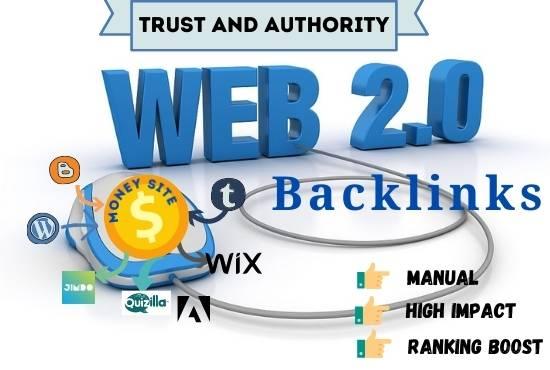In the world of SEO, backlinks remain one of the most crucial elements for boosting your website’s visibility and improving its search engine ranking. Among the various types of backlinks, Web 2.0 backlinks are especially effective for enhancing your SEO strategy. These backlinks come from user-generated content on Web 2.0 platforms such as WordPress, Blogger, and Tumblr, and they can significantly improve your website’s authority. But how exactly can you create Web 2.0 backlinks that will benefit your SEO efforts? In this guide, we'll walk you through everything you need to know about how to use Web 2.0 sites for backlinks that drive results.
What Are Web 2.0 Backlinks?
Before diving into the process of how to create Web 2.0 backlinks, let’s first understand what they are. Web 2.0 platforms are websites that allow users to create and publish their own content. These include popular platforms like WordPress, Blogger, Medium, Weebly, and others. Web 2.0 backlinks are created by linking to your website from content published on these platforms.
Web 2.0 backlinks are considered highly valuable by search engines because they come from trusted, high-authority domains. Moreover, these backlinks are contextually relevant when placed within quality content, making them a powerful tool in your SEO arsenal.
Why Are Web 2.0 Backlinks Important?
Web 2.0 backlinks play a vital role in SEO because they provide several benefits:
- Boost Search Engine Rankings: Quality backlinks from authoritative platforms can significantly improve your search engine rankings.
- Enhance Domain Authority: By acquiring backlinks from trusted Web 2.0 sites, your domain authority increases.
- Generate Referral Traffic: Web 2.0 backlinks drive traffic directly from the platform to your website.
- Increase Brand Visibility: Creating content on popular Web 2.0 sites enhances your brand's online visibility.
Now that we understand the importance of Web 2.0 backlinks, let’s explore how to create Web 2.0 backlinks step by step.
Step 1: Choose High-Quality Web 2.0 Platforms
The first step in how to create Web 2.0 backlinks is selecting the right platform. Not all Web 2.0 sites are created equal, and some offer better SEO value than others. Some of the most popular and authoritative Web 2.0 platforms include:
- WordPress.com
- Blogger
- Medium
- Tumblr
- Weebly
When choosing a platform, ensure it has a good reputation and high domain authority. It’s also essential to choose platforms relevant to your niche, as backlinks from niche-related Web 2.0 sites are more beneficial for SEO.
Step 2: Create High-Quality, Unique Content
Once you've selected your platform, the next step in how to create Web 2.0 backlinks is to create high-quality content. Search engines prioritize unique and valuable content, so it's crucial to write posts or articles that offer something new or helpful to your audience.
Your content should be relevant to your target keywords while also offering genuine value. Avoid copying content from your website—create fresh content that enhances your website’s overall authority and is likely to engage readers.
Incorporate your targeted keywords naturally into the content, including the anchor text for the backlinks. The key is to make the backlinks appear organic rather than forced.
Step 3: Add Backlinks Naturally Within the Content
The next step in how to create Web 2.0 backlinks is adding your backlinks in a way that feels natural and relevant. These links should be embedded within the body of your content, not just added to the footer or sidebar. The key is to make sure the backlinks are relevant to the topic and add value to the reader.
For instance, if your content is about SEO tips, you can naturally link to a page on your website that discusses more advanced SEO strategies. This context helps search engines understand the relevance of the link and boosts its SEO value.
Also, try to use descriptive anchor text instead of generic phrases like "click here." Anchor text that includes your keywords adds relevance to your link and improves SEO.
Step 4: Optimize Your Profile and Bio Sections
In addition to creating content, don’t forget to optimize your profile and bio sections on the Web 2.0 platforms. Most Web 2.0 sites allow you to add a short bio or description about yourself or your business. This is a great opportunity to include an additional backlink to your website.
Ensure your bio is well-written and professional, and include relevant links to your website or specific landing pages. Many platforms, such as WordPress.com and Blogger, allow you to place a link in the author bio section, which can further enhance your SEO.
Step 5: Add Multimedia to Your Web 2.0 Content
Incorporating multimedia such as images, videos, and infographics is another effective way to enhance your Web 2.0 content and make it more engaging. Adding relevant multimedia not only makes your content more visually appealing but also provides additional SEO benefits.
For SEO purposes, make sure to optimize multimedia elements with descriptive alt text and titles, and if possible, link to relevant pages on your website from the multimedia elements. This can further improve the SEO value of your Web 2.0 backlinks.
Step 6: Maintain Consistency and Build Links Over Time
How to create Web 2.0 backlinks effectively is not about creating a large number of links all at once. To get the best results, you need to maintain a steady pace in building quality backlinks. Regularly publishing content and adding new backlinks over time helps establish your website’s authority and ensures that your links appear natural to search engines.
Avoid spamming the Web 2.0 platforms with backlinks in a short period. A more gradual, organic approach will result in better SEO performance in the long run.
Step 7: Monitor Your Backlinks
Once you have created Web 2.0 backlinks, it’s important to monitor their performance. Use tools like Google Search Console, Ahrefs, or SEMrush to track the effectiveness of your backlinks. These tools will provide insights into which backlinks are driving traffic to your site and which need improvement.
If you find that some of your Web 2.0 backlinks are broken or outdated, be sure to update them or remove them. Regular monitoring ensures that your SEO efforts remain effective.
Conclusion: Mastering the Art of Web 2.0 Backlinks
In conclusion, creating Web 2.0 backlinks is a powerful strategy for improving your SEO and driving traffic to your website. By selecting the right platforms, creating high-quality content, and building relevant backlinks, you can significantly enhance your website’s authority and ranking. Consistency and quality are key to mastering the art of Web 2.0 backlinks.
Remember, creating Web 2.0 backlinks is a long-term strategy, and results may take time to appear. But with patience and persistence, you’ll soon see the positive impact on your website’s SEO and traffic. So, start today and build your Web 2.0 backlinks the right way to enjoy long-term SEO success.


